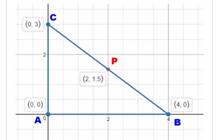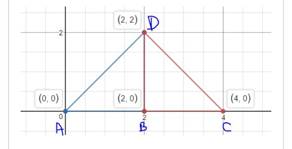
(a)
To find: The coordinate proof of the given statement.
(a)
Answer to Problem 27E
The work done by a force in moving an object from
Explanation of Solution
Given information:
The midpoint of the hypotenuse of a right angle is the same distance from each vertex of the triangle.

The above graph is a right angle triangle. From the graph it can be seen that the point
Now calculate the distance between the points
The distance between two points can be calculated by the formula,
The length of
Similarly, the length of
And,
From the above conclusion it can be clearly seen that the values of
Therefore, the midpoint of a hypotenuse of right angle triangle is equidistant from each of its vertex.
(b)
To find:The coordinate proof of the statement.
(b)
Answer to Problem 27E
The triangle
Explanation of Solution
Given information:
Any two congruent right isosceles triangles can be combined to form a single isosceles triangle.

In triangle
Hence, the triangles are congruent.
The length of both the triangles is
Thus, both these combine to form a single isosceles triangle.
Therefore, the triangle
Chapter 12 Solutions
BIG IDEAS MATH Integrated Math 1: Student Edition 2016
- 24.4. For the function g(z) defined in (18.7), show that g(z) = j=0 z2j (−1)³ (2j+1)!" Hence, deduce that the function g(z) is entire. 2 E C.arrow_forwardShow three different pairs of integers, a and b, where at least one example includes a negative integer.arrow_forwardShow three different pairs of integers, a and b, where at least one example includes a negative integer. For each of your examples, determine if each of the following statements are true or false:arrow_forward
- Construct a know-show table for each statement below that appears to be true.arrow_forwardRoedel Electronics produces tablet computer accessories, including integrated keyboard tablet stands that connect a keyboard to a tablet device and holds the device at a preferred angle for easy viewing and typing. Roedel produces two sizes of integrated keyboard tablet stands, small and large. Each size uses the same keyboard attachment, but the stand consists of two different pieces, a top flap and a vertical stand that differ by size. Thus, a completed integrated keyboard tablet stand consists of three subassemblies that are manufactured by Roedel: a keyboard, a top flap, and a vertical stand. Roedel's sales forecast indicates that 7,000 small integrated keyboard tablet stands and 5,000 large integrated keyboard tablet stands will be needed to satisfy demand during the upcoming Christmas season. Because only 500 hours of in-house manufacturing time are available, Roedel is considering purchasing some, or all, of the subassemblies from outside suppliers. If Roedel manufactures a…arrow_forwardShow three different pairs of integers, a and b, where at least one example includes a negative integer. For each of your examples, determine if each of the following statements are true or falsearrow_forward
- (a) Develop a model that minimizes semivariance for the Hauck Financial data given in the file HauckData with a required return of 10%. Assume that the five planning scenarios in the Hauck Financial rvices model are equally likely to occur. Hint: Modify model (8.10)-(8.19). Define a variable d, for each scenario and let d₂ > R - R¸ with d ≥ 0. Then make the objective function: Min Let FS = proportion of portfolio invested in the foreign stock mutual fund IB = proportion of portfolio invested in the intermediate-term bond fund LG = proportion of portfolio invested in the large-cap growth fund LV = proportion of portfolio invested in the large-cap value fund SG = proportion of portfolio invested in the small-cap growth fund SV = proportion of portfolio invested in the small-cap value fund R = the expected return of the portfolio R = the return of the portfolio in years. Min s.t. R₁ R₂ = R₁ R R5 = FS + IB + LG + LV + SG + SV = R₂ R d₁ =R- d₂z R- d₂ ZR- d₁R- d≥R- R = FS, IB, LG, LV, SG, SV…arrow_forwardThe Martin-Beck Company operates a plant in St. Louis with an annual capacity of 30,000 units. Product is shipped to regional distribution centers located in Boston, Atlanta, and Houston. Because of an anticipated increase in demand, Martin-Beck plans to increase capacity by constructing a new plant in one or more of the following cities: Detroit, Toledo, Denver, or Kansas. The following is a linear program used to determine which cities Martin-Beck should construct a plant in. Let y₁ = 1 if a plant is constructed in Detroit; 0 if not y₂ = 1 if a plant is constructed in Toledo; 0 if not y₂ = 1 if a plant is constructed in Denver; 0 if not y = 1 if a plant is constructed in Kansas City; 0 if not. The variables representing the amount shipped from each plant site to each distribution center are defined just as for a transportation problem. *,, = the units shipped in thousands from plant i to distribution center j i = 1 (Detroit), 2 (Toledo), 3 (Denver), 4 (Kansas City), 5 (St.Louis) and…arrow_forwardConsider the following mixed-integer linear program. Max 3x1 + 4x2 s.t. 4x1 + 7x2 ≤ 28 8x1 + 5x2 ≤ 40 x1, x2 ≥ and x1 integer (a) Graph the constraints for this problem. Indicate on your graph all feasible mixed-integer solutions. On the coordinate plane the horizontal axis is labeled x1 and the vertical axis is labeled x2. A region bounded by a series of connected line segments, and several horizontal lines are on the graph. The series of line segments connect the approximate points (0, 4), (3.889, 1.778), and (5, 0). The region is above the horizontal axis, to the right of the vertical axis, and below the line segments. At each integer value between 0 and 4 on the vertical axis, a horizontal line extends out from the vertical axis to the series of connect line segments. On the coordinate plane the horizontal axis is labeled x1 and the vertical axis is labeled x2. A region bounded by a series of connected line segments, and several…arrow_forward
- Consider the nonlinear optimization model stated below. Min s.t. 2x²-18x + 2XY + y² - 14Y + 53 x + 4Y ≤ 8 (a) Find the minimum solution to this problem. |at (X, Y) = (b) If the right-hand side of the constraint is increased from 8 to 9, how much do you expect the objective function to change? Based on the dual value on the constraint X + 4Y ≤ 8, we expect the optimal objective function value to decrease by (c) Resolve the problem with a new right-hand side of the constraint of 9. How does the actual change compare with your estimate? If we resolve the problem with a new right-hand-side of 9 the new optimal objective function value is| , so the actual change is a decrease of rather than what we expected in part (b).arrow_forwardStatement:If 2 | a and 3| a, then 6 a. So find three integers, and at least one integer should be negative. For each of your examples, determine if the statement is true or false.arrow_forwardStatement: If 4 | a and 6 | a, then 24 | a. So find three integers, and at least one integer should be negative. For each of your examples, determine if the statement is true or false.arrow_forward
 Advanced Engineering MathematicsAdvanced MathISBN:9780470458365Author:Erwin KreyszigPublisher:Wiley, John & Sons, Incorporated
Advanced Engineering MathematicsAdvanced MathISBN:9780470458365Author:Erwin KreyszigPublisher:Wiley, John & Sons, Incorporated Numerical Methods for EngineersAdvanced MathISBN:9780073397924Author:Steven C. Chapra Dr., Raymond P. CanalePublisher:McGraw-Hill Education
Numerical Methods for EngineersAdvanced MathISBN:9780073397924Author:Steven C. Chapra Dr., Raymond P. CanalePublisher:McGraw-Hill Education Introductory Mathematics for Engineering Applicat...Advanced MathISBN:9781118141809Author:Nathan KlingbeilPublisher:WILEY
Introductory Mathematics for Engineering Applicat...Advanced MathISBN:9781118141809Author:Nathan KlingbeilPublisher:WILEY Mathematics For Machine TechnologyAdvanced MathISBN:9781337798310Author:Peterson, John.Publisher:Cengage Learning,
Mathematics For Machine TechnologyAdvanced MathISBN:9781337798310Author:Peterson, John.Publisher:Cengage Learning,






